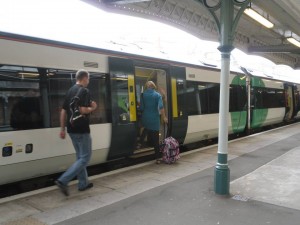…I left Bexhill. An hour on the train and 37 miles later and the world awaits. The first and arguably most crucial step, I was escorted by Sam from the Community Rail Partnership. I discover this stretch of line, the ‘Marshlink’ is not a popular route. I am stunned. The gateway to Europe and the world is waiting at (the now renamed) ‘Ashford International’. Since the Channel Tunnel opened, Ashford is the last stop before France, Belgium, Germany, and from there, well anything is possible. Train travel alone can take you to Singapore, India, Central Asia, North Africa.
The ‘Marshlink‘ is a hidden gem, a beautiful journey in itself. I can’t believe I haven’t made this trip before (on leaving the train at Ashford I had already promised myself to take this line more often, mentally planning future travel itineraries). Along the south coast with the shore line and coloured beach huts, and then up into the marshes (as it’s name suggests) with the open landscape of wilderness and wilds. I missed much of the scenery, engaged in animated conversation with Sam, so pledge to return for that part of the trip again.

Here we go…leaving Bexhill, UK (Louise Kenward, 2013)
Living in the south east of England, it is often under the shadow of London. To travel anywhere you must first reach or cross, or circumnavigate the city. Access to London is fantastic (debates around train services aside), I am grateful it is so close, but to go anywhere else in the UK it’s a time consuming irritant. I recently spent a particularly tedious afternoon rediscovering the M25 between junctions 4 and 5 in great detail. The only direction you can go without encountering the capital’s metropolis is south. When you live on the south coast this is pretty restrictive. The opening of the Channel Tunnel has changed this. Growing up in Kent, I remember writing about the prospect of the Channel Tunnel at school, a fairly fruitless exercise on arguing a debate. I didn’t know very much about it, there were some vague fears about being physically connected to France and the risk of animals with rabies wandering through, security risks and generally being closer to France. I was intrigued by the discovery that this had not been the first time such a venture had been mooted. The first proposal was in 1802. Albert Matieu was a French engineer with ambitions of digging the tunnel by oil lamp and with horse drawn carriage. In 1881 a pilot tunnel was made with a boring machine, stretching 1,893 metres from Shakespeare Cliff, and 1,669 metres from Sangatte. In 81 years the tunnel had made an average of almost 44 metres growth per annum. It did not seem promising. Coincidentally this was also the time Annie Brassey was venturing around the world on the ‘Sunbeam‘. The project was abandoned the following year owing to concerns a tunnel would jeopardise national defence. Sitting in my classroom I did not imagine for a moment it would happen. 2014 brings the twentieth birthday of the Channel Tunnel’s opening.
It was only later I learned that my uncle was involved in it’s construction. An explosives expert, there is a photograph album full of images of rock and dark spaces, wires and labourers as he documented his time there. Often with connected tales of camaraderie and work mates. So I feel some personal connection with the tunnel. Living so close to the entrance the opportunities for travel are amazing and, in part, provided the inspiration for my journey around the world. This time last year I arrived at Ashford, the first section of my journey complete. Small but perfectly formed, and in good company.

Ashford International, Louise Kenward (2013)
